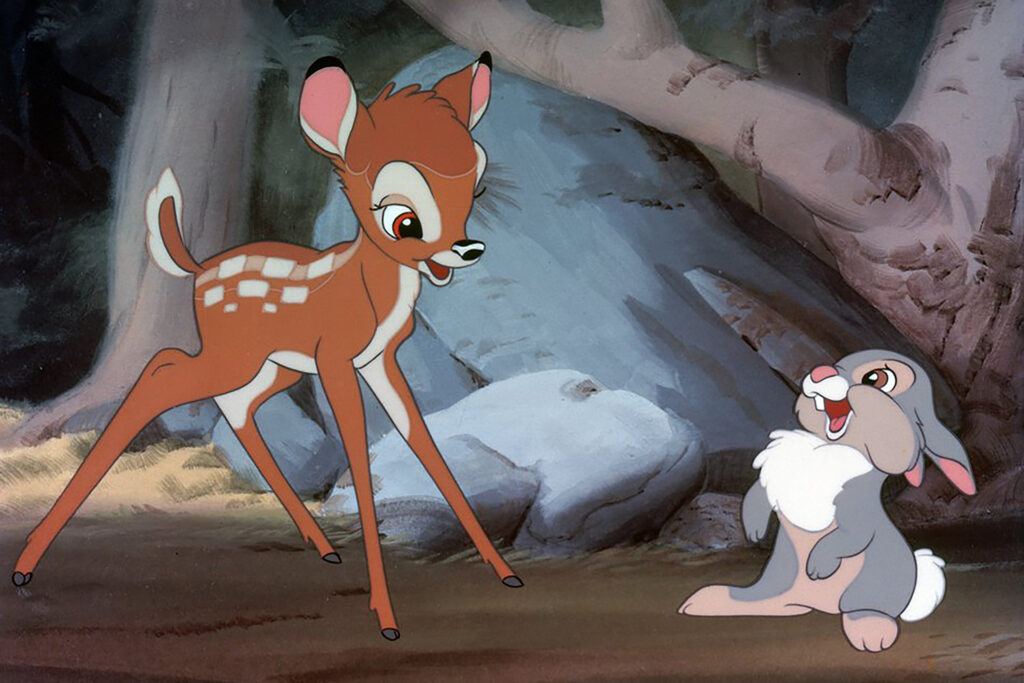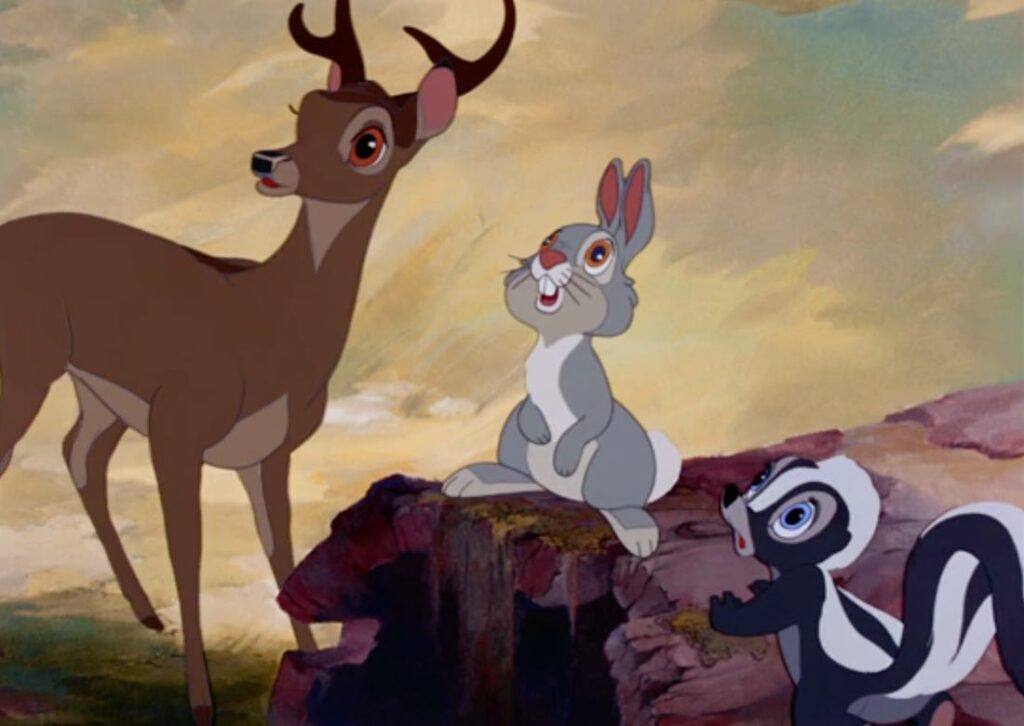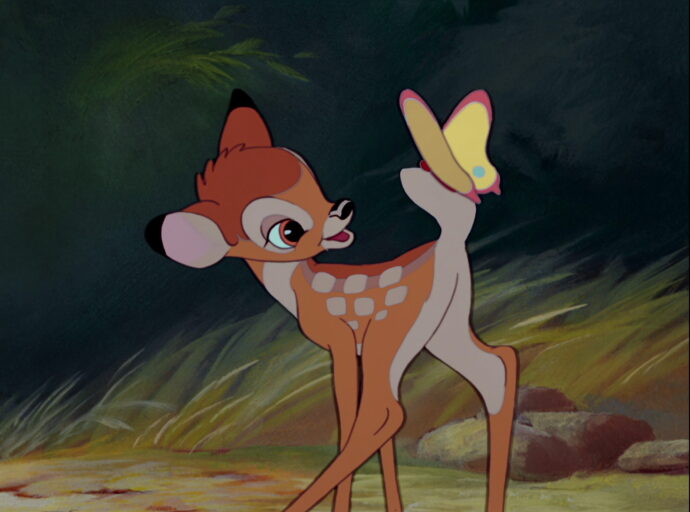Plus or Minus is a series detailing and analyzing every feature film now streaming on Disney+. It combines the unique history all these films share, their cultural impacts, and their qualities, or lack thereof. From timeless classics, to acquired hits, to DCOMs, no stone will be left unturned.
Disclaimer: Due to the heavy work needed on my cinemas essay, alongside other outside circumstances, Plus or Minus was put on an indefinite hiatus. I sincerely apologize for the lack of action, and I promise to stay more consistent on weekly reviews here. And now, let’s begin my Plus or Minus segment on Bambi.
We return from this retrospective with a big one. In this next iteration of Plus or Minus, we look at 1942’s Bambi, one Walt Disney’s personal favorite films of his. The film begins with the exciting birth of a fawn named Bambi. The child doesn’t know it yet, but when he grows old, he will become the Great Prince of the Forest. His father currently protects the forest from Man, keeping the animals safe from those who want to kill them.
And it’s through this 70-minute feature we follow the life story of Bambi. From his first steps to the friends he makes to finding his first love to dealing with loss to finally understanding what it means to be the Great Prince. And in turn, continue the legacy of his very father.
The Beauty of the Forest
The most striking element of Bambi comes from its animation. Because its story is a basic one, director David Hand creates a distinct mood through the designs and animations. The backgrounds boast amazing colors and lush landscapes. They truly emphasize the atmosphere of each frame. Special effects and lighting that bring such incredible dramatic heft, to the point where modern animation still fails to achieve it. Sequences that are emotional, surreal, and comedic are absolutely gorgeous to look at.
Yet with all that said, the one thing that really fascinates me when it comes to the art direction and animation are the characters. Not just in their designs, all of which are lively and distinct, but especially their movement. Animals in animation are typically very humanized in their appearance. Their facial expressions have distinct human characteristics. Their movements and gestures are very similar to a person’s body language.

It’s understandable why the directors and animators go this route. It gives these animal figures something human for an audience to latch onto. And obviously, there’s still anthropomorphic choices here. But the designs, body language, and expressions all feel animalistic. They move and communicate much like the animals you see in the wild. It’s very unique and impressive, considering this was still 1942. And it’s through the animation Bambi shines.
The Wonders of Life
As a story, Bambi doesn’t have a traditional structure. While Bambi does have an arc per se, it’s not really the focus of the story. The antagonist is Man, a vague, abstract force instead of an actual bad guy. There’s no real questions being asked or answers being told. It’s mainly moments and vignettes in the life of a deer. And that’s what oddly makes Bambi so engaging.
While there’s no real plot, there’s still something so fascinating over a movie about an animal’s life. There’s a distinct sense of atmosphere that makes the world and characters feel alive. The relationships every character faces is enticing and dramatic. And while Bambi is not a complex character, he serves as a charming blank slate that allows the audience to experience all kinds of distinct emotions. Life is full of confusing emotions. It is full of loss, love, and happiness. Life is a complex series of events that can be happy, scary, and emotional all at once.

Bambi showcases life in all its glory, warts and all. It’s certainly a unique story setup for a family film, and it’s one that works really well. Every vignette is memorable and packs a solid emotional punch that allows it to still be engaging. It’s truly engrossing stuff and the animators know how to use their talents in a way that makes each moment feel sincere and earned. Sometimes showing life is all you need to make a story compelling and beautiful, and it’s clear the crew knew just how to make this story dramatic and realistic.
Plus or Minus
Determining whether Bambi is a Plus or Minus is an easy one. Just about everybody is on the same page with this film. While it did garner mixed reviews at the time for its adherence away from the traditional Disney pieces, and the controversial death of Bambi’s mother, it’s now considered an all-time classic. Perhaps Walt’s biggest achievement in the medium of animation in fact. And it’s easy to understand why.
The world of Bambi is absolutely gorgeous, while the characters are endearing and likable. Its simple story about the many confusing aspects of life are still potent and resonant decades later. And through such a tight combination of gorgeous colors, memorable sequences, and charm to spare, Bambi is a masterclass in animated storytelling, and nothing has really been as experimental or unique as this, at least in mainstream animated fare.
Between Plus or Minus, it’s obvious Bambi is a Plus. Probably one of the most confident Pluses I have done thus far. And that’s saying quite a lot considering what I have already analyzed in this series.
NEXT TIME: We look at Saludos Amigos, one of the most obscure Disney animated features, yet one with an intensely fascinating production history all the same.
